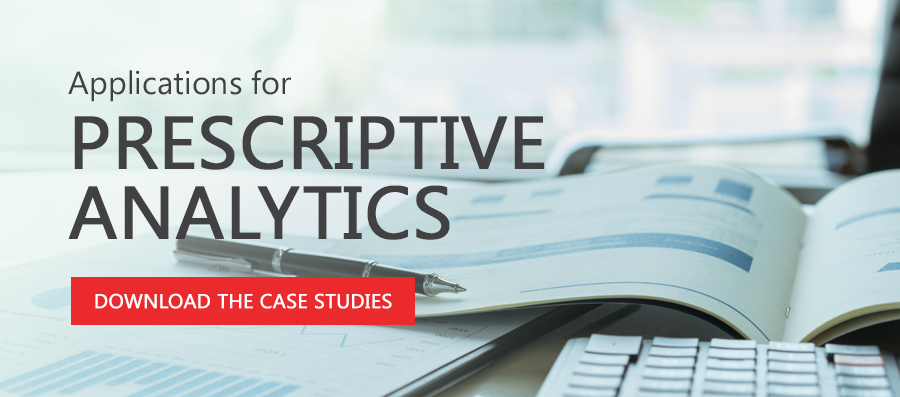Google search ‘descriptive analytics’ and ‘predictive analytics,’ and you’ll get 61.5 million and 71.4 million respective search options. However, search ‘prescriptive analytics,’ and you’ll only find a little more than 3.3 million. What gives? Why is it prescriptive analytics, the highest level of maturity in advanced analytics, is far less known that its category siblings?
While only 11% of mid- to large-size companies use prescriptive analytics today, the number of companies using this discipline is on a trajectory to triple in the next three years.
As a leading provider of this groundbreaking form of analytics, we wrote the book on prescriptive analytics (download the digital version of the book here), and in this post, we highlight other expert resources and uses in this growing field.
What the Experts are Saying About Prescriptive Analytics
Customers using our platform have primarily focused on corporate performance, supply chain and logistics, energy trading, mining, chemicals, healthcare and other verticals with cross-industry functions. However, the versatility of the prescriptive analytics platform continues to expand, as noted by others.
Leverages a Data-Driven Culture
“Making a good prediction doesn’t mean making a good decision. Reaching prescriptive analytics maturity requires deliberate, disciplined collection of performance data, reliable predictions, and continuously improved prescriptive algorithms. It also requires a company culture dedicated to data-driven practices.”
- Andrew Hutson, CTO
It’s the Key to End-to-End Optimization
“Pursuing enterprise optimization is nowadays much easier with the advent of next-generation prescriptive analytics software. Enhancements such as visual, code-free programming, embedded expert knowledge, financials incorporated out of the box, stochastic/what-if representations and the ability to deploy them in the cloud have brought down the time and effort required by as much as 80% while also reducing the risk.”2
- Carlos Centurion, President of River Logic
Provides Healthy Outcomes
“In the future, technology will step in and recommend the best course of action for patient circumstances. Prescriptive analytics will help determine what should go into the care plan for a specific type of patient, providing guidance within the workflow on the steps that will likely help care teams achieve a desired outcome,”
- LeRoy Jones, CEO

Leaders Must Prepare Themselves
“More and more, business leaders are becoming responsible for understanding how to appropriately leverage business analytics to drive value, both within their business unit as well as companywide. Simply being familiar with the types of business analytics is no longer enough, however; leaders must familiarize themselves with the kinds of problems for which each type of analytics is best suited. Prescriptive analytics is no exception to this.”
- Andre Boisvert, Board Vice Chairman and Senior Advisor, River Logic
Opens the Playing Field for Marketers
“Prescriptive analytics essentially makes the data you use more valuable by telling you what to use. This transcends predictive insights, which reveal what may happen if a specific decision is made. It’s end-game (but not end goal) data science for marketers because it opens the door to an entirely new playing field of possibilities.”
- Michael Brenner, Author of The Content Formula
Keeps Companies Ahead of Trends
“Some credit card and insurance companies use prescriptive analytics to analyze past factors like purchase history and credit score, to predict how a customer will behave in the future and what actions the company can take. Prescriptive analytics are action-based and help keep the company ahead of trends to make smart, future-focused decisions.”
- Blake Morgan, Customer Experience Futurist and Forbes contributor
Helps Retain Employees
“In the context of an HR problem, consider the problem of employee retention. Predictive analytics can help us predict which of our employees are most likely to quit. Prescriptive analytics would prescribe the course of action that is most likely to succeed in retaining these employees.”
- Sharlyn Lauby, HR Consultant
It’s Not Prescriptive If…
“For prescriptive analytics software — used to answer the question “what should I do?”— constraint-based modeling is not an optional feature; it’s a core philosophical foundation. It must be able to not only define and apply critical customer-specific constraints but also state the value of the constrained decision. This value can only be obtained by using established optimization techniques.”
- Eric Kelso, VP Product at River Logic
Going Beyond Predictive Analytics
“Prescriptive analytics also goes one step beyond what is referred to as ‘predictive analytics,’ which takes your current analytics models and makes the best guess at what will happen next. One such example is how your credit score is created based on your past history of credit card payments, debt owed and other factors, and a score is assigned based on a prediction of how you will behave in the future.”
- Greg Kihlstrom, Author of The Agile Brand
Beating the Competition
“Adopting prescriptive is critical for supply chains to gain a competitive advantage now and in the future. I firmly believe driving visibility and end-to-end optimization in the supply chain is the single biggest opportunity for transformation.”
- Leslie Keating, EVP Supply Chain Strategy and Transformation, Advance Auto Parts
Proactive Responses
“The speed of change is increasing. Prescriptive analytics helps finance leaders and their companies react quickly to proactively shape desired outcomes.”
- Phillip Higginbotham, VP Corporate Development at River Logic
Enabling Integrated Business Planning
“Integrated Business Planning has enabled us to accurately model the business including the financial and operational complexities, and, through the application of prescriptive analytics, provided us with the superior decision-making ability required in modern management.”
- Antonio Lira, Strategy and Business Planning Lead, Cemento Melon
Deeper Insights
“As enterprises strive for ways to better interpret data, they traditionally have relied on predictive analytics. However, as business becomes more competitive, organizations have realized they need to tap into even deeper insights and are beginning to look at the next level. By going beyond predictive analytics to leverage more advanced tools, such as prescriptive analytics, enterprises are able to leverage recommended actions that address uncovered insights.”
- David Judge, Vice President of Leonardo at SAP
Enhancing Decision-making
“The beauty of it is in how prescriptive analytics foresees what would be the effect of a particular decision taken, and the suggestions that it has to make to adjust the decisions that are actually made; ultimately enhancing the decision-making process and the bottom line of course.”
- Chirag Shivalker, Contributor at Analytic Bridge
No Longer for Data Scientists
“Optimization was traditionally applied by Operations Research professionals to solve operational problems, such as route optimization and logistics planning. With the advent of new technologies that make it possible to model larger, enterprise-wide problems, and provide broad support for what-if analyses, Prescriptive analytics now enables a new class of business analytics applications.”
- Preetam Kumar, Product Marketing Manager at IBM
It Can be Automated
“…prescriptive analytics can suggest decision options on how to take advantage of a future opportunity or mitigate future risk and illustrate the implication of each decision option. In practice, prescriptive analytics can continually and automatically process new data to improve prediction accuracy and provide better decision options.’
- Michael Walker, Contributor at Data Science Central
Redefining Business Decision-Making
“Through prescriptive analytics, organizations will redefine how business decisions are made.”
- Michael Elliott, Cloud Evangelist at NetApp
Having Your Back During Emergencies
“In an emergency situation, the business executives need the data-driven intelligence or data-driven solutions to better run their operations, but they do not have the time or skill to pursue Data Science. This is where Prescriptive Analytics come handy.”
- Paramita Ghosh, Contributor at Dataversity
Your Crystal Ball
“Prescriptive analytics basically offers organizations a crystal ball. Prescriptive analytics will become really powerful when it has developed into a stage where decision makers can predict the future and make prescriptions to improve that predicted future, without the needs for Big Data scientists.”
- Mark van Rijmenam, Founder of Datafloq
It’s Not What Comes After Predictive
“Many wrongly and incompletely define prescriptive analytics as what comes after predictive analytics. Our research indicates that prescriptive analytics is not a specific type of analytics, but rather an umbrella term for many types of analytics that can improve decisions. Think of the term “prescriptive” as the goal of all these analytics — to make more effective decisions — rather than a specific analytical technique.”
- Mike Gualtieri, Vice President and Principal Analyst at Forrester
It’s Feasible and Affordable
“Increased compute speed, decreased data storage costs and recent development of complex algorithms applied to diverse data sources and larger data sets has made prescriptive analysis feasible and affordable for most organizations.”
- Michael Walker, Contributor at Data Science Central
It’s Not a Black Box
“Simpler user interfaces make prescriptive analytics less of a “black box” solution that requires specialized knowledge to use. Managers can understand the “why” and “how” of optimization runs with simple, clean interfaces.”
- Nathan Goldstein, VP Partner Solutions at River Logic
Analyst Firms Tracking Prescriptive Analytics Software
Aside from the practitioners, we’ve listed several analyst firms (not all-inclusive or representative of analyst recommendations for your company) to show coverage on the subject, or certain aspects of it. For some firms, that includes the analytics evolution for the past several decades.
Gartner Research on Prescriptive Analytics
Gartner covers data analytics research for companies seeking solutions to their mission-critical priorities, in addition to conferences, consulting, and more. Gartner describes prescriptive analytics as a form of advanced analytics which examines data or content to answer the question “What should be done?” as an example, featuring techniques such as graph analysis, simulation, complex event processing, neural networks, recommendation engines, heuristics, and machine learning.
Ventana Research on Supply Chain Planning with Prescriptive Analytics
In the area of Supply Chain, Ventana Research describes prescriptive analytics technology as the advancement of analytic techniques, enabling businesses to undertake the challenge of supply chain optimization. Evolving from basic inventory optimization routines to more complex algorithms that address multiple objectives and constraints simultaneously, Ventana writes that analytics facilitate even complex scenario analyses to provide a complete picture of the future. Prescriptive analytics is more than being descriptive and explaining what just happened; it prescribes one or more options.

Forrester Research Calls Prescriptive Analytics the Black Belt of Digital Decisions
Forrester’s formal definition of prescriptive analytics is “any combination of analytics, math, experiments, simulation, and/or artificial intelligence used to improve the effectiveness of decisions made by humans or by decision logic embedded in applications.” Kate Leggett, Vice President, Principal Analyst, tracks CRM and customer service trends, providing insights to these less mainstream applications use of prescriptive analytics.
Events, Publications, and Books
On its own, prescriptive analytics may not be the most entertaining subject, but add applications on what it can do for the supply chain or industries like energy and healthcare, and prescriptive analytics delivers Oscar-type worthy results. To see more on the subject, check out these additional resources.
INFORMS
INFORMS (The Institute for Operations Research and the Management Sciences) is an international society for practitioners in the fields of operations research, management science, and analytics has more than 100 local chapters in the United States.
Additionally, it holds conferences and events, such as the upcoming 2019 INFORMS Business Analytics Conference.
Analytics magazine
Analytics is a free bi-monthly, digital magazine, providing readers with news and information that showcases the power of analytics on organizational decision making and outcomes.
The Ultimate Guide to Understanding Prescriptive Analytics
River Logic provides a vendor-neutral, interactive site that helps navigate the various approaches to prescriptive analytics, identify the transformational value it offers in the hands of business leaders (rather than Data Scientists / IT leaders), and how to determine if your company is ready to start a prescriptive initiative. You’ll find real-world, cross-industry examples, too!

In Closing
What we have discovered through our customers is that the dynamics are dramatically changing with the use of prescriptive analytics and how business is done today. With more insights available to more stakeholders, decision-making becomes data-driven, accurate, and efficient. Prescriptive analytics is delivering the best plans… not just a better plan.
1. Gartner IT Glossary, Prescriptive Analytics. Gartner Research.
2. Supply Chain Planning with Prescriptive Analytics. Ventana Research.






